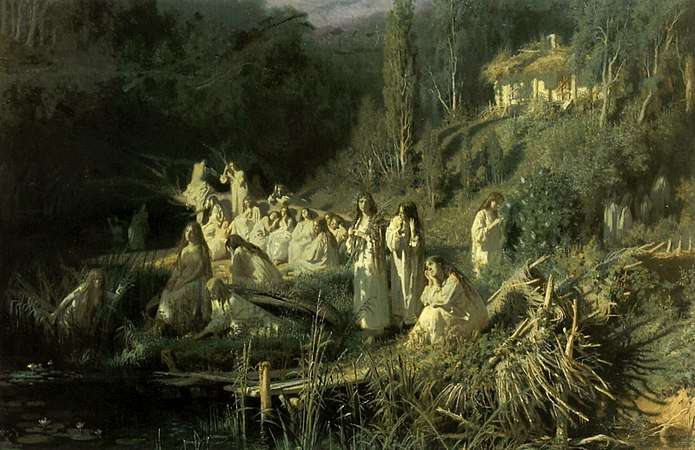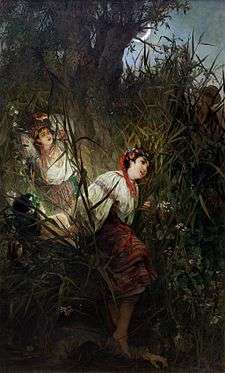Rusalka

In Slavic folklore, the rusalka (plural rusalki) (Russian: руса́лка, translit. rusálka; Polish: rusałka) is a female entity, often malicious toward humankind and frequently associated with water. Folklorists have proposed a variety of origins for the entity, including that they may originally stem from Slavic paganism, where they may have been seen as benevolent spirits. Rusalki appear in a variety of media in modern popular culture, particularly in Slavic language-speaking countries, where they frequently resemble the concept of the mermaid.
Origin and appearance

According to Vladimir Propp, the original "rusalka" was an appellation used by pagan Slavic peoples, who linked them with fertility and did not consider rusalki evil before the 19th century. They came out of the water in the spring to transfer life-giving moisture to the fields and thus helped nurture the crops.[1][2]
In 19th century versions, a rusalka is an unquiet, dangerous being who is no longer alive, associated with the unclean spirit. According to Dmitry Zelenin,[3] young women, who either committed suicide by drowning due to an unhappy marriage (they might have been jilted by their lovers or abused and harassed by their much older husbands) or who were violently drowned against their will (especially after becoming pregnant with unwanted children), must live out their designated time on earth as rusalki. However, the initial Slavic lore suggests that not all rusalki occurrences were linked with death from water.[2]
It is accounted by most stories that the soul of a young woman who had died in or near a river or a lake would come back to haunt that waterway. This undead rusalka is not invariably malevolent, and would be allowed to die in peace if her death is avenged. Her main purpose is, however, to lure young men, seduced by either her looks or her voice, into the depths of said waterways where she would entangle their feet with her long red hair and submerge them. Her body would instantly become very slippery and not allow the victim to cling on to her body in order to reach the surface. She would then wait until the victim had drowned, or, on some occasions, tickle them to death, as she laughed.[4] It is also believed, by a few accounts, that rusalki can change their appearance to match the tastes of men they are about to seduce, although a rusalka is generally considered to represent universal beauty, therefore is highly feared yet respected in Slavic culture.
Variations

While lore often says that the rusalki could not completely stand out of water, some fiction works tell of rusalki that could climb trees and sing songs, sit on docks with only submerged feet and comb their hair, or even join other rusalki in circle dances in the field. A particular feature of such stories revolves around the fact that this behaviour would be limited to only certain periods of the year, usually the summer (see Rusalka Week section).
Region-specific
Specifics pertaining to rusalki differed among regions. Although in most tales they lived without men, in Ukraine they were often linked with water (in Belarus they were linked with the forest and field). Where land was fertile, the maidens appeared naked and beautiful. In harsher areas of Russia, they appeared as "large breasted amazons".[5]
Rusalka Week
The rusalki were believed to be at their most dangerous during the Rusalka Week (Rusalnaya nedelja) in early June. At this time, they were supposed to have left their watery depths in order to swing on branches of birch and willow trees by night. Swimming during this week was strictly forbidden, lest mermaids would drag a swimmer down to the river floor. A common feature of the celebration of Rusalnaya was the ritual banishment or burial of the rusalki at the end of the week, which remained as entertainment in Russia, Belarus, and Ukraine until the 1930s.[6]
Modern popular culture
Regarding representations of the rusalka in modern popular culture, folklorist Natalie Kononenko says, "the currently dominant presents her as something like a mermaid, though she is picture as having legs rather than a fish tail ... The current view of the rusalka as a seductive or seduced woman was probably influenced by written literature. In the past, her image was more complex and she more closely resembled a nature spirit, found not only near water but in fields, forests, and mountains, rather like the vila ...".[7]
List of notable works featuring rusalki
- 1829 – "Rusalka" is a short story of Orest Somov (translated into English and published in 2016[8]).
- 1831 – "Rusalka" is a poem by Mikhail Lermontov.
- 1856 – Rusalka is an opera by Alexander Dargomyzhsky.
- 1895 – Roussalka is an unfinished opera by Henri Duparc.
- 1901 – Rusalka is an opera by Antonín Dvořák.
- 1908 – Su Anasy (tat. Су анасы; literary Water Mother, in Russian translation Vodyanaya) is a poem by Tatar poet Ğabdulla Tuqay.
- 1930s – In his poem, 'Rus ken nisht ontshlofn vern', Yiddish poet Itzik Manger re-imagines the biblical Ruth in early 20th Century Russia. The night before Naomi's departure, Ruth decides that if her mother-in-law does not take her with, she will throw herself in the river and become a rusalka.[9]
- 1943 – Nikolai Medtner's Third Piano Concerto is based on Mikhail Lermontov's ballad.
- 1979 - The Merman's Children by Poul Anderson had a Rusalka as the lover of one of the main characters.
- 1989 – Rusalka, a fantasy novel, part of The Rusalka trilogy of novels by C. J. Cherryh features and revolves around a rusalka named Eveshka.
- 1996 – a short film directed by Aleksandr Petrov, shown in Petrov's Paint-on-glass animation technique.
- 1996 – "To This Water (Johnstown, Pennsylvania 1889)," a short story by Caitlín R. Kiernan.
- 2005 – The Rusalka Cycle: Songs Between the Worlds is a performance piece and CD by the California-based women's vocal group Kitka.[10]
- 2013 – "Fatima Rusalka", a single by alternative metal band Alesana.
- 2016 – "The Book of Speculation: A Novel", Erika Swyler's debut, features rusalka characters in traveling circuses.
- 2017 – "Rusalka Pictures" is a British independent feature film production company.
- 2018 – "Rusalka, Rusalka / Wild Rushes", a song by American folk rock band The Decemberists on their album I'll Be Your Girl.
In popular culture
- 1993 – Quest for Glory: Shadows of Darkness, which draws upon Slavic mythology, features a Rusalka; Paladin characters have the option to avenge her murder and let her move on to the afterlife.
- 2006 – A cycle of creatures in the trading card game, Magic: the Gathering called Rusalka are printed in the Guildpact expansion.
- 2008 – In the video game Devil May Cry 4 a demon called Ba'el has two angler fish-like glowing feelers called Rusalka, they are used to entice human prey and resemble young, nubile women.
- 2008 – In the video game Castlevania: Order of Ecclesia Rusalka appears as the fifth boss, shown as an aquatic demon.
- 2010 – Rusalka is the name of a number station transmission ship in the video game Call of Duty: Black Ops
- 2012 – Rusalka is the name of a water nymph-like boss fought in the Nintendo 3DS video game Bravely Default.
- 2013 - Ruslakas appear as monsters in the action role-playing video game The Incredible Adventures of Van Helsing
- 2015 – "The Rusalka" is the name of episode three in season two of the television series Madam Secretary.
- 2015 – Rusalka is the name of a number of beings in the Playstation 4 video game Axiom Verge. In in-game dialogue, one rusalka translates this designation as a "water machine".
- Rusalka is a name of region where Tungaska Event happened in Ultraman Orb
See also
References
- ↑ Linda J. Ivanits (15 February 1989). Russian Folk Belief. M.E. Sharpe. pp. 78–81. ISBN 978-0-7656-3088-9. Retrieved 12 July 2015.
- 1 2 Elizabeth Wayland Barber (11 February 2013). The Dancing Goddesses: Folklore, Archaeology, and the Origins of European Dance. W. W. Norton. p. 18. ISBN 978-0-393-08921-9. Retrieved 12 July 2015.
- ↑ Zelenin, D.K, cited in Ivanits, Linda J. (1992). Russian Folk Belief. M.E. Sharpe. p. 76. ISBN 978-0765630889.
- ↑ "Rusalka". Internet Encyclopedia of Ukraine, Canadian Institute of Ukrainian Studies. University of Toronto Press. Retrieved 12 July 2015.
- ↑ Joanna Hubbs (22 September 1993). Mother Russia: The Feminine Myth in Russian Culture. Indiana University Press. p. 29. ISBN 978-0-253-11578-2. Retrieved 12 July 2015.
- ↑ Ivanits, Linda, Russian Folk Belief, p. 80.
- ↑ Kononenko, Natalie. 2007. Slavic Folkore: A Handbook, p. 18-19. Greenwood Press. ISBN 978-0-313-33610-2
- ↑ Somov, O 2016, The Witches of Kyiv and other Gothic Tales, Sova Books, Sydney
- ↑ Itzik Manger, Midresh Itzik, Hebrew University 1969.
- ↑ http://www.kitka.org/shop/the-rusalka-cycle-songs-between-the-worlds-cd
Further reading
- Hilton, Alison. Russian folk art. Indiana University Press, 1995. ISBN 0-253-32753-9.
- Д.К. Зеленин. Очерки русской мифологии: Умершие неестественною смертью и русалки. Москва: Индрик. 1995.
External links
